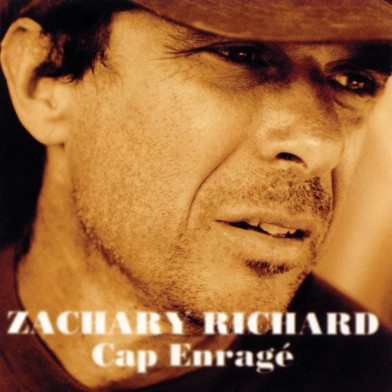Nearing its 20-year anniversary, Zachary Richard looks back on Cap Enragé, a record that changed his approach to the recording process and ushered in a return to his French language roots.
Cap Enragé was a formative album for me from the point of view of the recording process. Snake Bite Love was recorded in 1992 and much of the recording was done at Daniel Lanois’ studio on Esplanade [Kingsway]. I was greatly influenced by Lanois’ technique. Cap Enragé was, in effect, the next step in this evolution. Previously I had made albums in a very traditional mode, starting with the rhythm section and finishing with the vocals.
The approach of Cap Enragé was the inverse. We started with a guide vocal. Everything was built around the vocal. This allowed the vocal to determine the rhythm pattern.
When we were actually doing the album, much of the recording was done in Paris while I was in Louisiana. I’d get mp3s and I’d go, ‘What the fuck is this?’ You know, start breaking shit, and mow the yard.

“Usually it takes me a few years to ‘tame’ a record after it’s been recorded. For that period I will hear all the things that I could have done differently or better. After that time, however, the record becomes like an old friend…”
I was still under contract with A&M but I was on my way out the door and, all of a sudden, this thing kind of popped up. I can’t remember rolling on the floor laughing but it was a whole lot of fun. The producer would essentially record it in Paris while I was away. I’d go, ‘Oh this sucks!’ It always takes me a while to get used to the stuff anyway. It was an interesting process and I guess that’s why it’s one of the best albums that I ever made … because I wasn’t even in the same country with the recording. I really think I grew as a recording artist in the sense that before that album I spent a lot of time making sure that musicians did what I told them to do. And I realized with that album that was not the best way to get the most out of people. Since then, I’ve found the best people that I can and let them do what they do naturally. It was a learning experience for me. I think it was a watershed moment for me.
We [Richard and the producers] were able to communicate. That was really the beginning of that process of sending stuff around and having people record on it, bringing it all back to the same hard drive at some point. It was a real watershed event for me in a lot of ways.
They sent us stuff. Those cats were way on the front. I was rigged with some kind of … it would be a dinosaur today … but it was the beginning of digital recording. So I had a sort of mirror image of the system we were using in Paris. They sent me stuff on hard drives and I was able to play and record on it. I sold that piece of equipment for a boat anchor a couple years back because that’s about all it was worth. It was an Akai, some kind of recording thing big as a suitcase and it cost a lot of money, but I never used it after that.
Usually it takes me a few years to ‘tame’ a record after it’s been recorded. For that period I will hear all the things that I could have done differently or better. After that time, however, the record becomes like an old friend and I remember with nostalgia the session and the players. Cap Enragé is well beyond the deadline. I listen to it with no critical bias, just remembering all the fun I had.”




